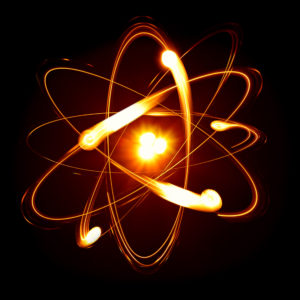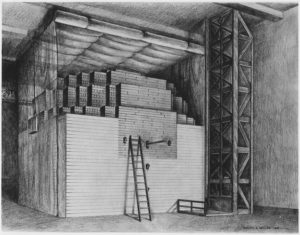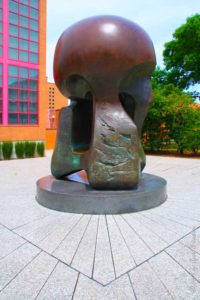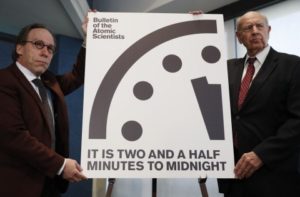
The Manhattan Project, featured in War, Spies, and Bobby Sox, was a key WW2 research and development project tasked with creating the world’s first nuclear weapon. Led by the US and supported by the United Kingdom and Canada, it ran between 1942 and 1946, directed by Major General Leslie Groves of the U.S. Army Corps of Engineers. Nuclear physicist J. Robert Oppenheimer directed the New Mexico lab, Los Alamos, which actually designed the bombs.
But prior to the move out to Los Alamos, before it was officially called the Manhattan Project, several different universities worked on a critical task that had to be achieved before a bomb could be produced. And the University of Chicago played a starring role.
Chicago’s Met Lab
The Metallurgical Laboratory at the University of Chicago, AKA the Met Lab, was one of several university physics departments across the country working to create a sustained nuclear reaction. Their job was to strip the nucleus of a uranium atom so that it would collide (and strip) another atom, and release a large amount of energy in the process. The process needed to be self-perpetuating, but it also had to be controlled. It was called fission.
 1939 saw a team at Columbia University – including Enrico Fermi, who directed the experiments, Leo Szilard, Walter Zinn, and Herbert Anderson – busy working on the fission process. Another team in California was also involved, as was the University of Chicago, under the leadership of Arthur Compton, Nobel Prize winner and Professor of Physics. Determined to bring about a self-sustaining nuclear reaction, Compton managed to persuade Fermi to move to the Met Lab in early 1942.
1939 saw a team at Columbia University – including Enrico Fermi, who directed the experiments, Leo Szilard, Walter Zinn, and Herbert Anderson – busy working on the fission process. Another team in California was also involved, as was the University of Chicago, under the leadership of Arthur Compton, Nobel Prize winner and Professor of Physics. Determined to bring about a self-sustaining nuclear reaction, Compton managed to persuade Fermi to move to the Met Lab in early 1942.
The Pile
The structure in which they conducted experiments was called the “pile,” because that’s what it looked like to the scientists. It was constructed on an old squash court under Stagg

Football Field, right in the center of the University campus. After months of experiments, the Chicago Pile went critical on December 2, 1942. It emitted a thermal output of 0.5 watts, a fraction of the eventual 200 watts it ultimately reached. Fermi’s design was a success, and eventually inspired the B Reactor at Hanford, the first full-scale reactor, as well as the X-10 Graphite Reactor at Oak Ridge, Tennessee.
Ryerson Lab and Eckhart Hall were also part of the Met Lab complex. James Schoke worked at Ryerson developing ways to detect and measure radiation, and both labs were hives of enthusiastic activity. As Fermi himself said, “The morale of the scientists could almost be plotted in a graph by counting the number of lights burning after dinner in the offices at Eckhart Hall.”
The End of the Beginning
Compton was keen to carry on building experimental piles and a chemical separation plant on the U of Chicago campus, but safety concerns led to Red Gate Woods, code-named Argonne, and the Oak Ridge site being chosen instead. At Argonne Forest, Chicago Pile-2 and Pile-3 were constructed, but the site was demolished after the war in favor of a bigger site in DuPage County. Argonne National Laboratory became the nation’s first ever national science and engineering lab.
 Ultimately, the entire project moved to Los Alamos, but the West Stands in Stagg Field weren’t demolished until 1957, replaced, in part, by the Regenstein Library. But plaques still commemorate Chicago Pile-1. And a huge bronze sculpture by mid-century British sculptor Henry Moore was installed in 1967 to mark the spot where CP-1 went critical.
Ultimately, the entire project moved to Los Alamos, but the West Stands in Stagg Field weren’t demolished until 1957, replaced, in part, by the Regenstein Library. But plaques still commemorate Chicago Pile-1. And a huge bronze sculpture by mid-century British sculptor Henry Moore was installed in 1967 to mark the spot where CP-1 went critical.
Today nuclear weapons are at the heart of the western world’s defenses. We’re just as terrified of them as ever, and the world’s non-proliferation agreement remains at risk. And yet no country with nuclear weapons seems prepared to decommission them. In fact, in 1947, the academic journal Bulletin of the Atomic Scientist created the famous Doomsday Clock, which measures how close the planet is to nuclear war. Midnight marks  the apocalypse, and the clock was originally set at seven minutes to twelve. Now, thanks to changing international politics, new technology, climate change, amongst other factors, the clock is set at just two and a half minutes to midnight. With Mr. Trump at the helm, it might have to be re-set again.
the apocalypse, and the clock was originally set at seven minutes to twelve. Now, thanks to changing international politics, new technology, climate change, amongst other factors, the clock is set at just two and a half minutes to midnight. With Mr. Trump at the helm, it might have to be re-set again.